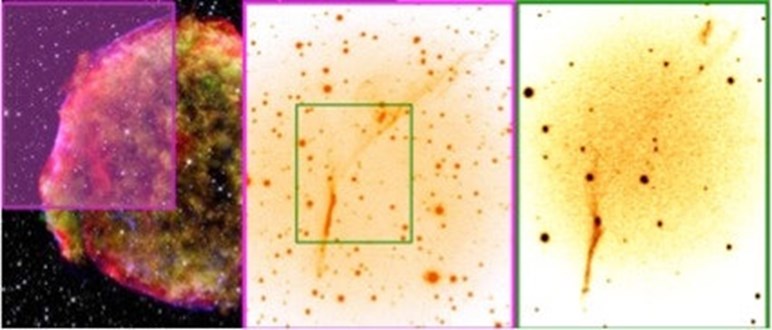Left. Composite image of the remnant of Tycho Brahe's supernova (1572) using data from the Chandra x-ray satellite observatory (yellow, green, blue: credits NASA/SAO), from the Spitzer infrared satellite observatory (red: credits, NASA/JPL-Caltech), and from the Calar Alto observatory (stars white: credit, Krause et al.). The transparent magenta box shows the field of the ACAM instrument at the Cassegrain focus of the William Herschel Telescope (WHT, ORM, La Palma). Centre, a zoom-in on the ACAM field with a green box showing the size of the field of the 2d spectrograph GHaFaS (WHT, ORM). Right. The reduced and integrated image of GHaFaS in the emission from ionized hydrogen (Ha).
Credit: NASA/SAO, NASA/JPL-Caltech
An exploded star first seen by 500 years ago helps astrophysicists to solve a cosmic conundrum. Andrew Masterson reports.
Ending an astronomical mystery, scientists have confirmed that cosmic rays – high energy subatomic particles – are produced within at least one supernova.
The rays, which consist primarily of protons and atomic nuclei, continuously bombard the Earth’s atmosphere. It’s been known for decades that they originate from outside the solar system, even perhaps outside the galaxy, but how and where they are created has until now remained obscure.
Now research published in the Astrophysical Journal finds that an as yet unknown mechanism within exploding stars is the likely source. The mechanism acts as an accelerator, producing an unexpectedly wide range of particle velocities that cannot be accounted for by the mass and temperature of the gases involved.
The discovery was made by a team led by astrophysicist Sladjana Knežević of the Weizmann Institute of Science in Israel, using an instrument known as GHaFaS, mounted on the 4.2m William Herschel Telescope at the Roque de los Muchachos Observatory in the Canary Islands.
The team focussed the instrument’s attention on a supernova known formally as SN 1572, but more commonly as Tycho’s supernova, after the pioneering astronomer Tycho Brahe who first recorded its existence in in 1572.
The supernova – more correctly, a supernova remnant – has been studied several times in recent years, including by British radio-astronomers in the 1950s, and observers at the California’s Mount Palomar Observatory a decade later. NASA’s orbiting Chandra X-ray Observatory imaged it in 2002.
None of these investigations, however, had sufficient resolution to test the hypothesis that supernovae may be the source of cosmic rays.
Using the Canary Islands facility, Knežević and her colleagues mapped a section of the dissipating cloud that surrounds the Tycho remnant, including a bright, visible filament. Measuring two levels of hydrogen emission spread, the team found that the results only made sense if somewhere in the remnant an accelerator was producing high energy particles.
The finding is the first time evidence for such a mechanism has been found, and appears to confirm supernovae as the source of cosmic rays.
The data has important implications for both astrophysics and particle physics.
The researchers now intend to combine their results with other measurements of Tycho’s supernova already taken by another facility on the Canary Islands, the larger Gran Telescopio Canariasto, to gain a clearer picture of cosmic ray acceleration.

